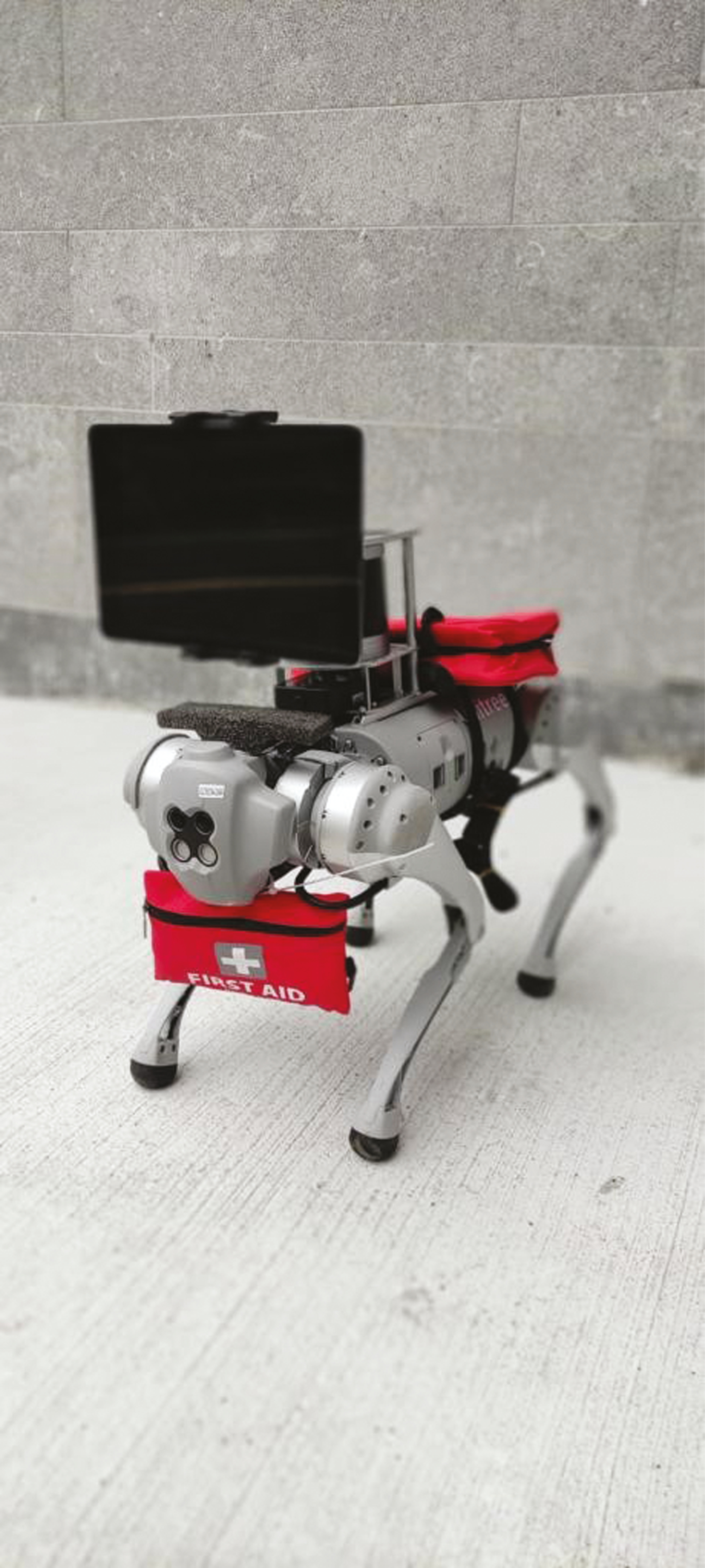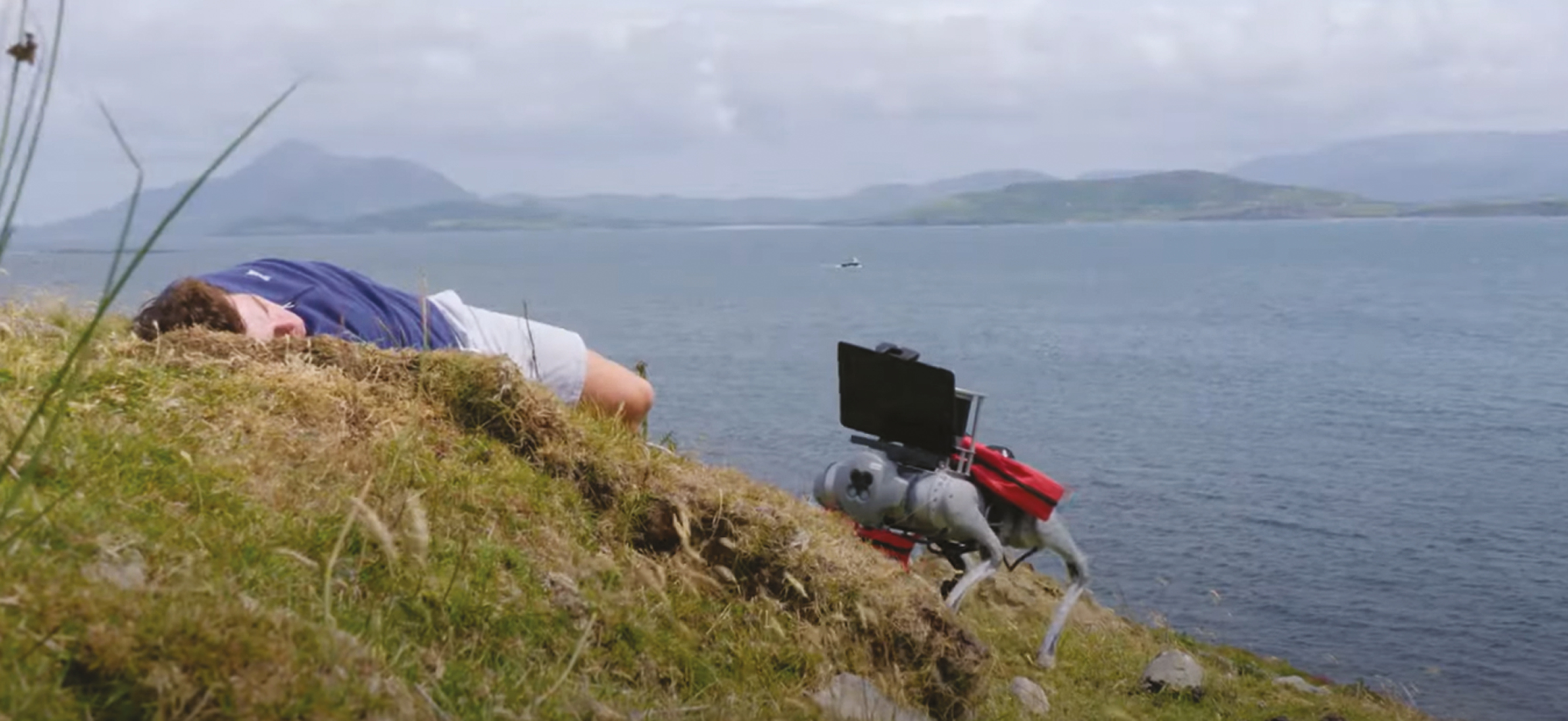
Medical emergency calls can occur at any time and place, especially high-risk rescue operation emergencies in challenging environments such as difficult topography and remote locations. The friendly canines have been a longer companion to humans and have shown themselves to be highly effective in several search and rescue operations, popularly the St. Bernard dogs, in the past few centuries in the alpine regions of Switzerland [1]. The field of quadruped robotics have significantly advanced in its initial capabilities for locomotion and navigation and can operate in various complex terrain and surfaces. The various generations of the modern quadruped robot, now functional with an array of cameras and sensors, have been used for a variety of automated inspection and surveillance purposes [2].
The state-of-the-art quadruped robot dogs have advanced technologies, such as 3D mapping and global positioning system (GPS), which allows the creation of detailed spatial models in real time. Together, these technologies empower robot dogs to navigate complex environments, employing autonomous navigation and dynamic obstacle avoidance techniques to locate and reach patients [3]. The quadruped robot current geo localization allows for integration of satellite maps which further improves accurate positioning [4].
There are inherent limitations of the traditional rescue dog approach such as the extensive training requirements, the expensive care needs and short supply of suitable animals. However, the robot dog approach overcomes these limitations, and capitalizes on advanced technologies to create robust scalable solution for deployment in remote medical emergencies. Considering the above, we sought to explore the potential of this quadruped robot dog as an immediate first responder in a pilot simulation study on a remote Irish offshore island.
The digital St. Bernard dog robot developed for this proof-of-concept simulation was nicknamed MADRA, the Irish word for dog (Figure 1). In addition, it was an acronym for Medical Autonomous Droid Remote Assistant. MADRA was based on a commercially available quadruped robot, Unitree Go1, Edu version (Unitree Robotics, Hangzhou, China) equipped with 3D mapping system, tablet device and emergency medical kit including the Epinephrine pen (EpiPen) for acute allergic reactions, finger pulse oximeter, glucose meter, glucagon and an automated external defibrillator (AED).


MADRA (Medical Autonomous Droid Remote Assistance) equipped with a medical kit
A structured simulation following on accepted scenario progression methodology (based on the template created by Jean Pearce & Katie McDermott, members of the Pediatric Simulation Program ) begins when a witness comes across the scene, and attempts to attend the simulated unconscious person [5]. Across all medical and healthcare disciplines and informed by global competencies models, it becomes apparent that there is a need to productively exploit the advantages offered by technology in terms of adaptive and responsive learning spaces. Aligned with this, there have been calls for medical and healthcare practitioners to become more familiar and comfortable with the technologies for when they are used in clinical setting. This research builds on best practice and existing literature in digital heath education and in particular healthcare curriculum development [6]. The witness sends GPS coordinate to the emergency team of on-call remote clinical and technical professionals. MADRA is deployed from the base station to the given GPS location and assists the witness with access and support to a dual audio–video call with a medical expert to achieve the optimum triage and rapid response (Figure 2). This simulation took place in a monitored outdoor setting and under direct control of an operator.


Robot dog achieving a triage beside an unconscious person (actor), Clare Island
MADRA was evaluated for technical and clinical impact. Technical outcomes included ability of robot to navigate rough terrain, maintain two-way communications and deliver the medical supplies. Clinical impact was evaluated to assess the effectiveness of remote triage of the injured patient. From an operational standpoint, the robot demonstrated good capability over uneven terrain; however, it was noted that its average speed of 14 km/hour decreased as the terrain variability increased. The system maintained an excellent cellular communication link with the base station throughout. In addition, the robot had sufficient battery to allow for continuous operation for 1 hour, enabling it to comfortably complete its mission (with a 5 km range from the base). From a clinical standpoint, MADRA provided two-way audio–visual communication and delivered emergency medical supplies to the scene of the accident, enabling the use of specialized equipment (e.g. AED) by the person who was first on the scene and who summoned the digital St. Bernard dog.
The learning outcomes from this first-in-kind outfield simulation were to test the feasibility, effectiveness and overall potential of the robot dog in assisting a remote triage and first response situation. The robot dog was able to perform the desired controlled simulation and received positive feedback from the evaluators on the innovative approach in facilitating human and robot interaction. The two-way audio–video stream from the robot-dog camera feed facilitated substantially in making effective clinical decisions and guiding the simulated first responder at the scene.
We plan to trial more iterations for this simulation with different learning groups to understand the perceived attitudes and usefulness of human and robot interactions in the healthcare setting. The interdependency in relying upon robotic elements for everyday manual or repetitive physical tasks is projected to increase across society including healthcare.
Now that the remote medical triage field simulation scenario has been developed and tested, the next phase of the research will be to evaluate and optimize the learner and operator educational experience. This developed simulation scenario will be appropriate for the training of first responders as well as mountain rescue and wilderness medicine clinicians. The limitations of this outdoor simulation scenario include technical, clinical and environmental challenges that are more onerous than traditional indoor healthcare simulation. Specifically, there was a requirement to have sufficient expertise to program and operate the robot dog. Future development should follow the hive like intelligent collaboration between aerial drones and the quadruped robots for complete autonomous operation.
None declared.
The authors contributed equally to this research.
The authors gratefully acknowledge funding through Science Foundation Ireland (SFI) via Cúram - Ireland’s Centre for Research in Medical Devices (Research Centre Award Reference: 13/RC/2073) and through Industry Partnership with CISCO Systems Ireland Ltd. through its Community Digital Accelerator (CDA) Programme. Additional funding through the Department of Public Expenditure and Reform (DPER) was gratefully received as part of the Future Tech Challenge award 2022.
None declared.
None declared.
1.
2.
3.
4.
5.
6.